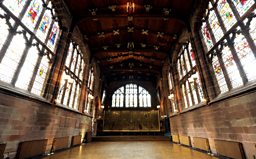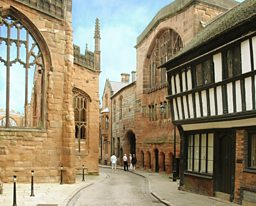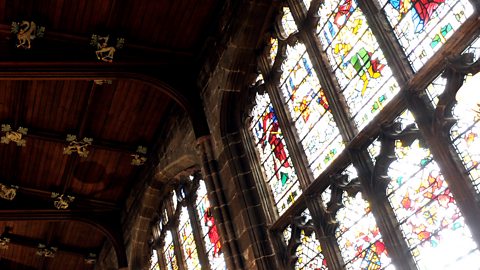St Mary's Hall Coventry, a miraculous survival
As the seat of civic government and the centre for festive occasions, St Mary's Hall was probably the venue for most performances by touring entertainers before the mayor and city officials during the Elizabethan and Stuart period.
The hall continued in use by performers into the 18th century, including the famous Shakespearean actress Sarah Siddons, among others.
-
![]()
Much ado near me
Hear more Shakespeare stories on BBC Coventry & Warwickshire
-
![]()
Shakespeare Festival 2016
The BBC celebrates the genius of the bard

When the bombs fell on Coventry in November 1940, destroying three-quarters of the city centre and St Michael’s Cathedral, St Mary's Hall in narrow Bayley Lane directly across from the Cathedral, miraculously survived. The arched entrance from the street still leads to a courtyard with the red sandstone hall on the upper storey in the west range, the entrance via a narrow, winding staircase accessed through a door in the east range.
The hall itself, boasting an intact minstrels gallery, would have been a splendid performance space, 30 foot wide by 72 foot long, rivalling palace halls and theatre stages in London.
A special feature remains at the high end – a late 15th century tapestry and the stained glass window commemorating Henry VI and his lineage. The tapestry was commissioned by Henry VII to hang in St Mary's Hall as part of a plan to canonize his predecessor who was revered by Coventry in part because he had granted the city special status as a county. Probably Flemish in design and weave, it represents the Assumption of the Virgin with the apostles and kneeling figures of Henry VI and his Queen.
What an evocative backdrop to staging in front of (but not on) the dais the tapestry and windows would have made for companies known to have had the Henry VI plays in their repertory!
Pembroke’s company, perhaps with Shakespeare among them, played Coventry on their 1593 tour when all three Henry VI plays were available to them – probably around the same time that they visited the Berkeley family at Caludon Castle nearby. The King’s players also toured through Coventry several times, starting with their first tour, when they were driven from London by the plague in 1603.

They too would have had some of Shakespeare’s history plays in their repertory, a good choice and likely a popular one in the city which features as a rallying point in several of the plays. The King’s Men are known to have appeared at Coventry some time between 19th May and 31st October 1603, with a reward of 40 shillings; on 29th October 1608 for a reward of 20 shillings; sometime during a year running from 1st November 1613 to 31st October 1614, again for 40 shillings; and on 10th January 1620, with 33 shillings received from the mayor’s purse.


Did Shakespeare come to Coventry?
The BBC's Moira Rawlings met Blue Badge guide Roger Bailey to find out more
Shakespeare on Tour
From the moment they were written through to the present day, Shakespeare’s plays have continued to enthral and inspire audiences. They’ve been performed in venues big and small – including inns, private houses and emerging provincial theatres.

BBC English Regions is building a digital picture which tracks some of the many iconic moments across the country as we follow the ‘explosion’ in the performance of The Bard’s plays, from his own lifetime to recent times.
Drawing on fascinating new research from Records of Early English Drama (REED), plus the British Library's extensive collection of playbills, as well as expertise from De Montfort University and the Arts and Humanities Research Council, Shakespeare on Tour is a unique timeline of iconic moments of those performances, starting with his own troupe of actors, to highlights from more recent times. Listen out for stories on Shakespeare’s legacy on your BBC Local Radio station from Monday 21 March, 2016.
You never know - you might find evidence of Shakespeare’s footsteps close to home…
Craig Henderson, BBC English Regions
Coventry in Shakespeare's time
By the 15th century, Coventry had emerged as an important Midlands city, one of the few in the kingdom to be granted a royal charter as a county in its own right.
Farewell, sweet lords. Let's meet at Coventry.Henry VI, Part 3
Situated on the South-East edge of the region once covered by the Forest of Arden, Coventry lay at the hub of an important network of roads linking it with London, Worcester, Holyhead, Leicester, Gloucester and the South-West.
No wonder that it was a mecca for touring acting companies who showed up to perform regularly, according to records surviving from the 1570's to 1642.
Actors did not have to contend with hostile civic authorities here in friendly Coventry and the King’s Men were rewarded handsomely for all their performances.
-
![]()
Shakespeare Lives
The nation’s greatest performing arts institutions mark 400 years since the Bard's death
Related Links
Shakespeare on Tour: Around Coventry and Warwickshire
-
![]()
The year that Shakespeare's home town banned plays
A dramatic decision by the Stratford-upon-Avon town council explained
-
![]()
Macbeth at the back of the Craven Arms, Southam
Southam mentioned in Shakespeare's Henry VI Part Three
-
![]()
Caludon Castle: Did Shakespeare perform here for ‘Henry the Harmless’?
Was Shakespeare there during the 1593 'Plague Tour'?
Shakespeare on Tour: Around the country
-
![]()
Ira Aldridge
Ira Aldridge - the first black Shakespearean actor
-
![]()
Blossoming at the Rose Theatre
Shakespeare, budding playwright and actor, at the Rose Theatre from the spring of 1592
-
![]()
Will Kemp dance finished in Norwich
Why did Will Kemp, Shakespeare's former clown, dance from London to Norwich?
-
![]()
London's Female Romeo
Charlotte Cushman, the American actress who took Victorian London by storm










